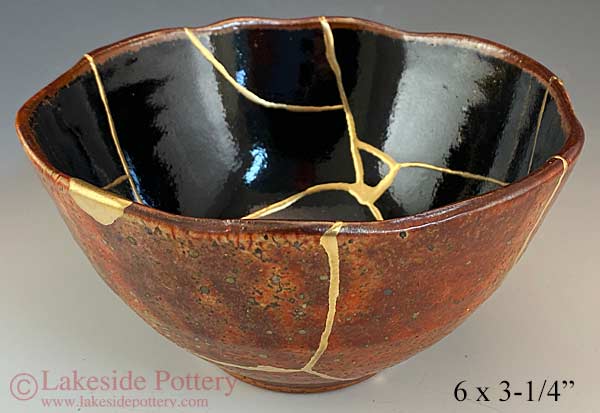Mending with Gold

Kintsugi is the Japanese art of putting broken pottery pieces back together using an adhesive of gold and lacquer — so expressing the notion that in embracing flaws and imperfections, an even stronger, more beautiful piece of art is created with the mended pieces.
We all have suffered breaks and so are imperfect and flawed, but we need to move on and regard them as part of who we are or as something that makes us complete.
When a broken thing is repaired it must have had some value to justify the cost of repair, and to this a further dimension of beauty and character would have enriched its original state. A repaired vase turns into an altogether different artwork, the piece that was too symmetrical becomes more beautiful with the jigsaw of its golden veins - while one that lacked cohesiveness in its original form may find that cracks give it unity.
It’s our flaws and pockmarks that tell who we are. Every bit of damage we suffer in the rough and tumble of life will leave scars and make us stronger and better. After grief we become different and in Kintsugi the scars are of gold - the break is acknowledged.
Hemmingway reflected that the ultimate value of our lives is decided not by how we win, but by how we lose, and went on to say that the world breaks everyone and after a crisis many are found to be strong in their broken places – like a Kintsugi vase, more resilient after repair.
Broken pots and lives don’t have to stay broken; we often hear of people who have been bereaved in terrible circumstances gain new purpose. It’s not often that the most joyous moments in our lives are the most significant but it is those that leave us less comfortable that allow the feelings and character to develop and come out. The withered, tarnished, weathered often have a special beauty and character – a mature love compared to an infatuation, an old and bent woman as opposed to a model.
In the realm of music, errors can creep in, so for example, in the ‘blues’ which is a tolerant form – mistakes often sound intentional, or even if they don’t, they just sound ‘bluesy’ so giving a sense of unpolished expressiveness
A Kasugai bowl contains a memory of what it used to be, a recognition of suffering and resilient beauty that is more than just a means of repair Kasugai offers us a hope of new opportunities of service, a resurrection.
….. a woman came with an alabaster jar of very expensive perfume, made of pure nard. She broke the jar and poured the perfume on his head (Mark 14 v 3)
And the house was filled with the fragrance of the perfume. (Jn 12v3)
The broken released a beautiful fragrance!
Robert Lucas, 25/05/2022